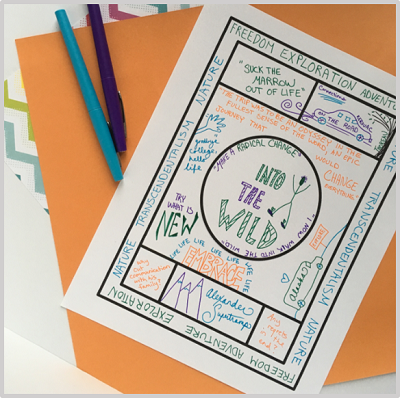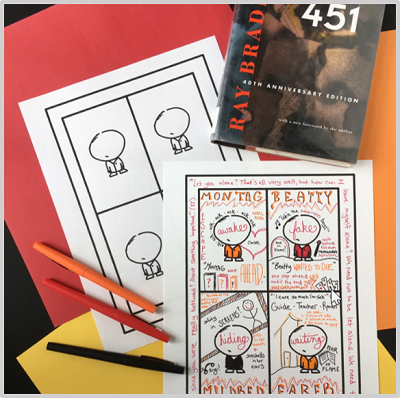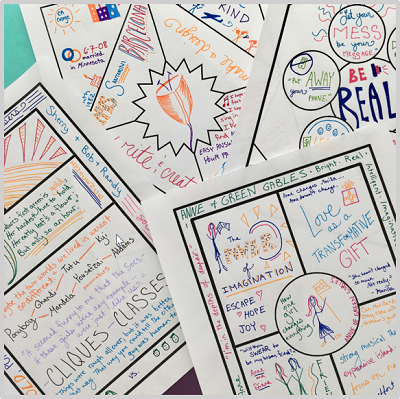

BLOGS > AUGUST 4, 2021
BY BETSY POTASH

But are one-pagers really all about art? At its core, a one-pager (originally developed as a classroom tool by AVID) is a no-fluff, just-the-good-stuff version of a set of information. In the business world, a boss might ask an employee to create a one-pager of six months of research so the boss can catch up. In English class, a teacher might ask a student to create a one-pager out of an entire novel, pulling the most important information and ideas from its pages and sharing it through words and images. Either way, it’s about finding the core of what’s worth taking away from something.
One-pagers can seem like the best or the worst pedagogic tool available, depending on what example you happen to be looking at. We tend to see the upper reaches of the example mountain on Instagram. But can one-pagers be useful even if your students aren’t planning their tours of Rhode Island School of Design (RISD)?
It turns out they can.
To find success with one-pagers, just follow three simple steps.
While you’re sure to get some interesting one-pagers if you ask students to simply condense what’s important about a text or unit into one page of information and images, you’re also going to get some terrible ones. It helps students succeed with one-pagers if you lay out exactly what you want included.
For example, for a one-pager on a novel, you might bullet the following elements:
You can tailor these expectations to any type of information, whether you’re asking for a one-pager on a novel, poem, short story, film, or podcast. You can even use one-pagers as a tool to learn more about students, having them create one-pagers about themselves, their reading histories or their families.

Creating a short rubric that shows how hitting the important elements thoughtfully leads to a strong grade on the assignment. This will help take away the anxiety from students who are uncomfortable with art. It will also make it a lot easier for you to quickly grade your one-pagers and get them up into a display on your classroom wall.

Even with a list of elements to include and a rubric, many students (especially those who hate art), will feel nervous around one-pagers at first. That’s where templates come in. Simply create a page divided into shaped sections and attach each necessary element to a section. It’s amazing how much it helps students relax into the assignment if instead of asking them to include two themes, you ask them to include two themes in the upper left hand rectangle. Simple, but highly effective.
Of course, some students will prefer artistic freedom. Simply differentiate by offering the template as an option, and let students choose. You’ll get creative work through both formats.
Once you get going with one-pagers, you’ll quickly see how versatile they are and how much the combination of imagery and ideas makes information memorable to your students.

Be sure to save time (once the one-pagers are created) for a gallery walk or mini-presentations to a partner or small group. Let your students see each other’s one-pagers so they continue to expand their ideas of what one-pagers can be like so they’re ready for further depth and innovation the next time you assign one.
|

BETSY POTASH
Betsy’s passion is helping English teachers build innovative and creative lessons. Get inspired and follow along with her at
Get Ahead of the 2026 ALA YMAs with These 5 Must-Read Contender Titles
October 23, 2025
This month, we’re diving into the most buzzworthy books of the year – handpicked by our Curation Team from our ALA Youth Media Award Contenders book list. These standout titles are generating serious award chatter, and we’re reading them now to...
Read more
Celebrate holidays with 12 seasonal titles!
October 13, 2025
Motivate students to read with these seasonally themed books from Capstone Publishing! Spark their interest with books focusing on holidays they know and love and give them the chance to discover new ones they’ve never heard of.Three lucky educators will receive these...
Read more
Pippa Park Books Come to Life in Video Series!
September 19, 2025
Middle graders aren’t reading for pleasure like they used to, and educators, booksellers, and families want a solution to get them excited about reading and sharing stories with their peers again. One part of such a solution is to meet...
Read more
Preview exciting fall 2025 eGalleys from Capstone!
September 15, 2025
We’ve partnered with Capstone and NetGalley* to provide digital access to 15 upcoming nonfiction and fiction titles releasing January 1, 2026. You’ll want to take advantage of this early access so you can then preorder the titles you love on...
Read more
Why the Food Group Series Continues to Take the Cake
September 15, 2025
From The Bad Seed to The Smart Cookie, Jory John and Pete Oswald’s Food Group series has become a staple in classrooms and libraries across the country. With its clever characters, laugh-out-loud humor, heartfelt lessons, and captivating illustrations, the series has helped educators...
Read more
Fall Into Reading with Orca Book Publishers
September 15, 2025
Keep students reading all year long by sprucing up your classroom’s library with these top titles from Orca!All the Things We FoundBy Joanne LevyAudience: Upper ElementaryIn this story about loss, protagonist Ruthie finds herself in a park where she meets an...
Read more